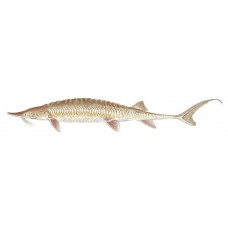Latin name
Scaphirhynchus platorinchus
Other names
Hackleback sturgeon
Identification
The shovelnose sturgeon has a broad, flat head with an elongated shovel-like snout. There are four spines under the snout, the two middle spines being almost as long as the outer ones. All four are in a straight line in front of the mouth. The body is brown to gray with five rows of shields (bony scales). The upper lobe of the caudal fin is longer than the lower and has a filamentous extension that may be obliterated in older individuals. There are scales under the body as well as on the caudal fin.
Distribution
The shovelnose is found in the same range as the lake sturgeon. Its range is the Mississippi River basin from western Pennsylvania to Montana and south to Louisiana; the Mobile Bay drainage in Alabama and Mississippi; the headwaters of the Rio Grande in New Mexico.
Habitat
This species prefers the fast flow of large rivers with sandy or gravelly bottoms, but can also live in muddy water.
Size
The average adult shovelnose sturgeon is about 20 inches long and weighs 11⁄2 pounds. A large specimen will weigh about 5 pounds. They rarely exceed 3 feet or 6 pounds, but can grow to 10 pounds. Shovelnose sturgeon are smaller than pallid sturgeon, which are also found in the Mississippi River system.
Life history and Behavior
Spawning begins at 5 to 7 years of age and takes place on sand and gravel in large channels with fast currents.
Food and feeding habits
The Shovelnose feeds exclusively on aquatic insect larvae on the bottom, which make up the bulk of its diet. It may occasionally feed on small fish.
Reproduction
No information
| Classification | |
| Phylum | Chordata |
| Class | Actinopterygii |
| Squad | Acipenseriformes |
| Family | Acipenseridae |
| Genus | Scaphirhynchus |
| Species | S. platorynchus |
| Features | |
| Conservation status | Vulnerable |
| Habitat | Bottom |
| Life span, years | No information |
| Maximum body weight, kg | 4.8 |
| Maximum length, cm | 100 |
| Sailing speed, m/s | No information |
| Threat to people | Edible |
| Way of eating | Bentophage |
Sturgeon, Shovelnose
Tags: Sturgeon, Shovelnose

